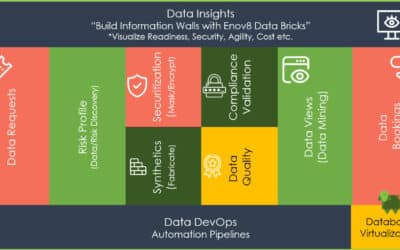
Release Management Explained in Depth
April, 2024
by Carlos Schults.
Author Carlos Schults
This post was written by Carlos Schults. Carlos is a .NET software developer with experience in both desktop and web development, and he’s now trying his hand at mobile. He has a passion for writing clean and concise code, and he’s interested in practices that help you improve app health, such as code review, automated testing, and continuous build.
Do you want to ensure that your software releases meet the highest quality standards, while also satisfying security and compliance requirements? Release management is a crucial process that can help you achieve this goal. In today’s fast-paced business world, where software development is becoming increasingly complex, adopting a robust release management process can make all the difference.
Innovate with Enov8
A Platform of Insight
Managing your IT & Test Environments, Releases & Data.
In this in-depth article, we’ll dive into the key stages of release management, its benefits, and best practices for its effective implementation. Whether you’re a software developer, project manager, or IT professional, this article will provide you with the insights you need to streamline your release process and improve your software delivery capabilities.
What Is Release Management?
Let’s open the post by defining its topic. So, what is release management?
In simple terms, release management is a process for controlling all of the details of how software is deployed into production. Of course, the devil is in the details.
Taking software from source code to an official release is an extremely complex process in any organization. So release management has to account for development, testing, deployment, support, and all of the environments, processes, and controls that go along with those activities.
In fact, this can be so complex in the enterprise that there is a specific term for it. Enterprise Release Management (ERM) is release management specifically designed for large companies coordinating many different software releases. You can read more about ERM in our post, Enterprise Release Management: The Complete Guide.
Release Management Components Glossary
Before we get into release management in detail, here’s a useful glossary of important components in the release management process:
- Release: In release management, a release is a new or updated version of a software product that goes through a defined process to reach end users.
- Release pipeline: The complete path from planning a feature to successfully delivering it.
- Release template: A template for a release pipeline. It should contain both automated and non-automated tasks.
- Release plan: An occurrence of a release template for a given release.
- Release unit: A set containing one or more release artifacts, delivered into production together to implement the approved feature.
- Release package: Release units which are combined into a release package for deployment.
The Release Management Process
Release management orchestrates the smooth flow of software updates from development to testing to, ultimately, live environments. It’s a meticulous dance of planning, scheduling, and control, ensuring the right features land in user hands at the right time with minimal disruption. Effective release management is a risk-mitigation powerhouse, safeguarding quality, stability, security, and compliance throughout the process.
While the specifics of release management differ by company and product, some common stages include:
- Planning and Scheduling: Release management involves detailed planning and scheduling to determine the best time for software releases. This includes assessing factors such as market demand, customer readiness, and internal resource availability.
- Risk Management: Mitigating risks associated with software releases is a fundamental aspect of release management. This involves identifying potential risks, developing mitigation strategies, and implementing measures to safeguard against unforeseen complications.
- Coordination and Communication: Effective release management requires seamless coordination and communication across various teams and stakeholders. This ensures that all parties are aligned and informed throughout the release process.
- Quality Assurance: Ensuring the quality of software releases is paramount. Release management involves implementing robust quality assurance processes to validate the integrity and functionality of the released software.
- Deployment Planning: Planning for deployment is a critical component of release management. This includes determining the most suitable deployment methods and ensuring that all necessary resources are in place for a successful deployment.
Key Roles in Release Management
A successful software release relies on a well-coordinated team effort. In this section, we’ll delve into the key roles that play a vital part in the release management process, from planning and development to testing and deployment. The specific roles involved in release management can differ based on company structure, but some key players typically include:
- Release Manager: Oversees the entire release management process, ensuring smooth coordination between different teams and stakeholders. In Enterprise Release Management, this is the Enterprise Release Manager.
- Release Coordinator: Manages the day-to-day activities related to the release process, including scheduling, communication, and issue resolution.
- Development Team: Implements features, resolves bugs, and incorporates enhancements as outlined in the release plan.
- Testing Team: Conducts various types of testing, such as unit testing, integration testing, and user acceptance testing, to ensure the quality of the release.
- Operations Team: Handles deployment activities, including configuring servers, updating databases, and ensuring compatibility with other systems.
- Business Stakeholders: Provide input on release priorities, requirements, and objectives based on business needs and goals.
- Change Advisory Board (CAB): Reviews proposed changes and assesses their potential impact on the organization before approving them for release.
- Documentation Team: Maintains accurate documentation of release processes, procedures, and changes for reference and compliance purposes.
- Support Team: Provides post-release support, addressing any issues or questions raised by users or stakeholders.
- Security Team: Ensures that releases comply with security policies and standards, conducting security assessments and implementing necessary measures to protect systems and data.
Each role plays a crucial part in the release management process, working collaboratively to ensure successful and efficient software releases.
The Benefits of Effective Release Management
The release management process is critical for any organization that produces software products or services. Effective release management can help organizations achieve several benefits, including:
- Reduced risk of release failures: By using a standardized release process and incorporating automation tools, organizations can reduce the risk of human error and ensure release deployments are consistent and reliable.
- Improved release quality: Release management can help ensure releases are thoroughly tested and meet customer requirements before deployment, reducing the likelihood of defects and customer issues.
- Increased customer satisfaction: By delivering high-quality releases on a regular basis, organizations can improve customer satisfaction and loyalty.
- Enhanced collaboration and communication: Release management involves multiple stakeholders, which can help promote collaboration and communication across teams, leading to better decision-making and faster time-to-market.
- Better visibility and control: Release management provides visibility into the software development process, enabling organizations to identify and resolve issues quickly and effectively.
- Happy stakeholders & steering committees.
Release Management Tools
A good release management tool should help organizations automate, standardize, and streamline the release process, while providing visibility and control over the entire release process. Below are some key features to consider when selecting a release management tool:
- Release Automation: Eliminate repetitive tasks like testing and deployment with robust automation features. This frees up your team’s time for higher-value activities and reduces the risk of human error.
- Standardized Release Process: Define clear release phases, roles, responsibilities, and criteria for a consistent and predictable release process.
- Early Stakeholder Involvement: Integrate stakeholders like product owners, developers, testers, and business analysts from the get-go to ensure releases align with customer needs and minimize defects.
- Communication and Collaboration: Foster effective communication and collaboration across teams with built-in collaboration platforms and communication channels.
- Continuous Process Improvement: An ideal tool will help your team synthesize feedback and metrics to pinpoint areas for improvement and implement changes for a constantly evolving and efficient release process.
One tool that meets these criteria is Enov8 Release Manager, an enterprise-level release management tool that provides a comprehensive set of features for managing the release process. Enov8 Release Manager offers capabilities for automation, standardization, stakeholder involvement, communication, and collaboration, as well as advanced reporting and analytics features for continuous process improvement. By using Enov8 Release Manager, organizations can improve their release management process and deliver high-quality software products and updates to customers on a regular basis.

Release Management Best Practices
Now you can see that release management is a vast area that covers many different activities. What all of those activities have in common is that their goal is one and the same—deliver value to the customers. Despite being comprised of all of those different tasks, release management is defined by some practices that help manage the release process in a cross-functional manner. You’re now going to learn about the four best practices for effective release management, namely multi-project release coordination, environment management, automated release reporting, and continuous process improvement.
Multi-Project Release Coordination
Software organizations will often work in massive releases that include several projects, and they need to keep a consolidated calendar for all projects. Such a calendar should include the deployment of the component projects to the enterprise environment.
Environment Management
This best practice has to do with metrics. It consists of tracking requirements for the environments used for delivering software. It supports decision making about the provisioning of such environments.
Automated Release Reporting
Successful release management hinges on tracking key metrics and KPIs (key performance indicators) across all processes and resources involved. Presenting these metrics in clear, concise reports for stakeholders empowers them with valuable insights. This transparency facilitates faster issue identification and continuous improvement of the release process.
Continuous Process Improvement
Since you can’t improve what you don’t measure, it’s crucial to track and measure metrics that are related to the performed releases. By tracking these metrics across the whole pipeline, organizations can put an iterative approach in place in order to improve their delivery processes.
Release Management in Agile and DevOps
DevOps and agile are two of the most popular frameworks in software today. Release management is the cornerstone of successful DevOps, ensuring smooth software delivery. Agile methodologies seamlessly integrate with release management, fostering faster iterations and more frequent deployments.
Release Management and DevOps
DevOps and release management are two sides of the same coin. DevOps creates a fast-flowing software delivery pipeline, while release management acts as the control center.
Here’s how they work together:
- Automation (CI/CD): Automated testing and deployment within DevOps streamline release tasks.
- Collaboration: Dev and ops teams work together throughout the process, fostering shared responsibility.
- Frequent Releases: Smaller, frequent deployments allow for faster feedback and quality control.
Release management in DevOps is all about smooth, controlled releases within a rapid delivery pipeline.
Release Management and Agile
Agile breaks down development into smaller, manageable features, while release management focuses on getting those features to users smoothly. Agile Release Trains (ARTs) enter the scene for large-scale projects, coordinating multiple agile teams working toward a common goal.
Here’s the breakdown of how agile and release management work together for delivering high quality software:
- Smaller, Manageable Chunks: Agile delivers features in smaller increments, making releases less risky and easier for both individual teams and the ART to manage.
- Faster Feedback Loops: Agile’s emphasis on quick iterations allows for faster feedback on releases, leading to quicker improvements within each agile team and across the ART.
- Continuous Improvement: Both agile and release management prioritize continuous learning and improvement, ensuring a smooth and adaptable delivery process, even for complex projects managed by ARTs.
Together, agile and release management, with the potential addition of ARTs for larger projects, create a flexible and responsive system for software delivery.
Conclusion
Release management is an essential process for any organization that wants to ensure that its software releases meet the highest quality standards. By adopting best practices and leveraging the right tools, teams can streamline their release process, minimize errors, and increase collaboration between different departments. With the ever-increasing complexity of software development, effective release management has become more critical than ever. By implementing a robust release management process, organizations can stay ahead of the curve, deliver software faster, and ultimately achieve greater success. So, if you’re looking to optimize your software delivery capabilities, start by adopting a comprehensive release management strategy today!
Innovate with Enov8 Enterprise Release Manager
Enov8 Release Manager is a comprehensive solution designed to simplify and optimize release management processes. By leveraging the capabilities of Enov8 Release Manager, organizations can automate and orchestrate their release activities, improve collaboration between different teams, and gain end-to-end visibility into the entire release pipeline. With Enov8 Release Manager, organizations can achieve faster, more reliable software releases while minimizing the risk of errors and disruptions. So, if you’re looking for a powerful tool to streamline your release management process, consider Enov8 Release Manager today!
Relevant Articles
8 DevOps Anti-Patterns to Avoid
It’s the normal case with software buzzwords that people focus so much on what something is that they forget what it is not. DevOps is no exception. To truly embrace DevOps and cherish what it is, it’s important to comprehend what it isn’t. A plethora...
An Introduction to Application Rationalization
In today's fast-paced digital landscape, organizations often find themselves grappling with a sprawling array of applications. While these applications are crucial for various business operations, the lack of a structured approach to managing them can lead to...
What Makes a Great Test Data Management Tool
What Makes a Great Test Data Management Tool? In today's fast-paced IT landscape, having a robust Test Data Management (TDM) tool is crucial for ensuring quality, compliance, and efficiency in software development and testing. At Enov8, we pride ourselves on providing...
The Top Application Portfolio Management Tools
Managing an application portfolio is essential for organizations aiming to optimize their IT operations, reduce costs, and enhance overall efficiency. Application Portfolio Management (APM) tools are designed to help organizations achieve these goals by providing a...
What Is a Test Data Manager?
Testing is a critical aspect of software development, and it requires the use of appropriate test data to ensure that the software performs optimally. Test data management (TDM) is the process of creating, storing, and managing test data to ensure its quality,...
Sprint Scheduling: A Guide to Your Agile Calendar
Agile sprints can be a powerful, productive and collaborative event if managed properly. However, when neglected or set up incorrectly they risk becoming chaotic and inefficient. Crafting an effective schedule for your sprint is essential to ensure the success of your...










